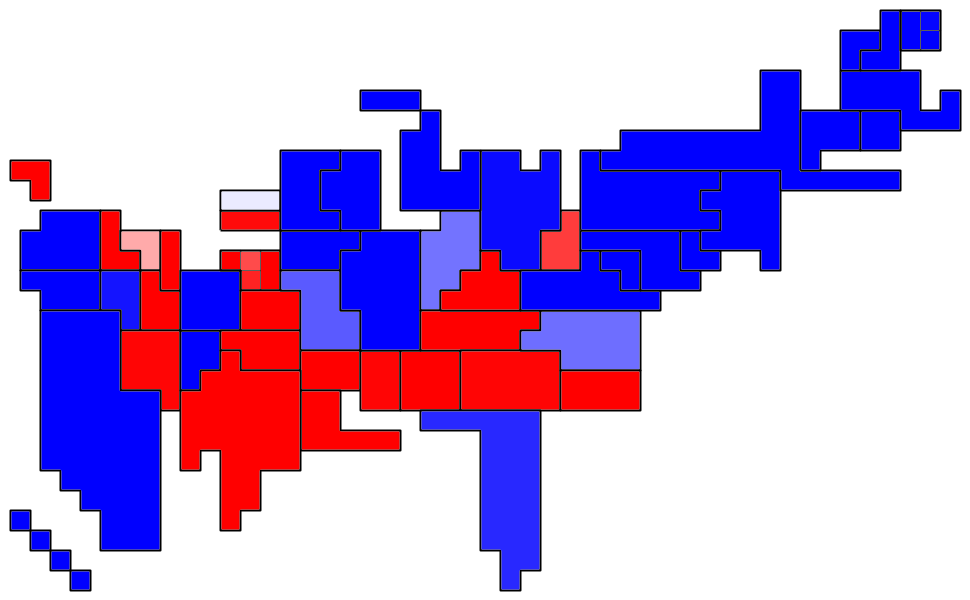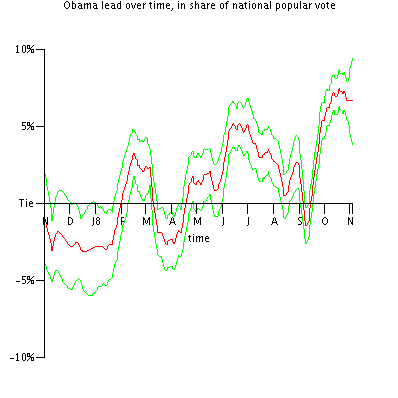Roundup up other sites
Sam Wang is right that there's a ceiling to the number of EVs that Obama is likely to get, that that ceiling is around 380 EVs (I'd call it 386), and that the race is a lot more stable now that you would think based on some other sites. (This is part of why I'm only bothering to update every week or so.)
The big media companies continue to have an interest in increasing ad revenue by making people think that the race is close. CNN in particular behaved this way in the primaries until the moment Clinton conceded (long after I had decided it wasn't worth the effort to calculate Clinton-McCain forecasts), and continues to do so now. No intelligent, disinterested person could simultaneously think that IN is still "lean McCain" but that NV is still "tossup," as CNN purports to.



4 Comments:
I have followed the same four tracking polls for the past month: Research2000/Daily Kos, Diageo/Hotline, Rasmussen, and Gallup (registered voters). In Gallup's case, I look at the other methods but since they haven't been out there for very long, I use the one that's been there the whole time.
Kos is liberal. Rasmussen is Republican. Gallup is Gallup. Hotline has the smallest sample and therefore is most volatile.
Obama hit a peak about a week ago at an average of +9.5%. Today (Monday 20 October) he is at an average of +7%, up from +6.75% on Sunday. Most of the tightening seems to be from the bottom, i.e., from McCain moving from the low 40s toward the mid-40s. I attribute this to the McCain campaign's use of various rhetorical strategies to rally the base.
From what I've seen, and from what I believe will happen with the black vote and to a degree with the youth vote, I think Obama is going to wind up with 53-54% of the vote, just as your model predicts.
If anything, there would be upside from there, with one reservation: Republican efforts to suppress black voting. I think the "Acorn" scandal is a cover for such efforts, which I believe will be most effective in FL and CO.
However, the Republicans won't be able to steal OH again, like I think they did in 2004. And there is a whole lot more early voting this year, so I think it will be hard for them to steal NC and FL. But they'll try.
Where oh where does anonymous come off with his post? Such off the wall ramlings.Same old false museing from a warped left thinker > thinker, yea right.
Ben, I don't think it's quite fair to assert that "no intelligent, disinterested person could simultaneously think that IN is still 'lean McCain' but that NV is still 'tossup'". Granted, polls are giving Obama a bigger lead in NV than they are giving one to McCain in IN, but by very little (According to pollster, Obama's NV edge is less than 2 pts greater than McCain's IN edge.), but polling in NV has been more volatile, while to my knowledge, Obama's trendline has never been above McCain's in Pollster, and IN has never been colored blue in, say, 538's projections.
It may be that the mean of the distribution of outcomes for IN is farther from a zero-margin than it is for NV, but the variance (over time, at least) for NV is greater, so Obama's greater margin in NV may be less reliable than McCain's smaller margin in IN.
The argument here is certainly not controlling, but it's a reasonable one that an intelligent, disinterested person could find persuasive.
Smackdown!
I stand corrected -- Jason is right that one could logically believe that NV has more volatility than IN based on higher volatility in NV polling. (As it happens, more recent polling has been far more volatile in IN than NV.)
Implicit in this argument is the idea that volatile polling in a state is indicative of volatility in the state, rather than some other cause, such as high non-sample error from difficult polling conditions. I think these competing hypotheses would be tough to verify or disprove. In the absence of a great way to measure state-by-state volatility, my model uses an assumption that volatility is the same in all states. This may be the wrong assumption, but the effect of the volatility estimate will be insignificant by election day because of the enormous amount of daily polling.
(By the way, 538 has now caught up, and has colored IN blue.)
Post a Comment
<< Home